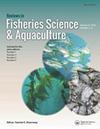Stomach Emptiness in Fishes: Sources of Variation and Study Design Implications
引用次数: 55
Abstract
This study summarizes fish stomach content data from 369,000 fish from 402 species in 1,096 collections and reports on the percentage of individuals with empty stomachs. The mean percentage of individuals with empty stomachs among all species, locations, habitats, seasons, regions, and collection methods was 26.4%. Mean percentage of individuals with empty stomachs varied significantly among fish collection gear types, taxonomic orders, trophic groups, feeding behaviors, and habitats, and with species length at maturity. Most of the variation in percentage of individuals with empty stomachs was explained by species length at maturity, fish collection gear type, and two autecological factors: trophic group (piscivore percentage of individuals with empty stomachs > non-piscivore percentage of individuals with empty stomachs) and feeding habitat (water column feeder percentage of individuals with empty stomachs > benthic feeder percentage of individuals with empty stomachs). After accounting for variation with fish length, the percentage of individuals with empty stomachs did not vary with the stomach removal collection method (dissection vs. gastric lavage), feeding time (diurnal or nocturnal), or time of collection (day or night). The percentage of individuals with empty stomachs was similar between fresh and saltwater fish, but differed within finer habitat classifications and appeared to follow a general prey availability or productivity gradient: percentage of individuals with empty stomachs of open ocean collections > estuary collections, lentic > lotic, and pelagic > littoral. Gear type (active or passive) was the most influential factor affecting the occurrence of empty stomachs that can be readily controlled by researchers.鱼的胃空:变异的来源和研究设计的意义
本研究总结了1096次采集402种369,000条鱼的胃内容物数据,并报告了空腹个体的百分比。在所有种类、地点、生境、季节、地区和采集方式中,空腹个体的平均百分比为26.4%。空腹个体的平均百分比在不同的渔具类型、分类顺序、营养类群、摄食行为和生境以及鱼种长度之间存在显著差异。空腹个体百分比的变化主要由成熟时的物种长度、渔具类型和营养类群(空腹个体的鱼食性百分比>空腹个体的非鱼食性百分比)和摄食生境(空腹个体的水柱食性百分比>底栖食性百分比)两个生态因子解释。在考虑了鱼的长度变化后,空胃个体的百分比与胃切除收集方法(解剖与洗胃)、喂养时间(白天或夜间)或收集时间(白天或晚上)没有变化。在淡水和咸水鱼类中,空腹个体的比例相似,但在更精细的栖息地分类中则有所不同,并且似乎遵循一般的猎物可用性或生产力梯度:开放海洋群落>河口群落,水域>水生群落和远洋>滨海群落的空腹个体百分比。齿轮类型(主动或被动)是影响空腹发生的最重要因素,研究人员可以很容易地控制。
本文章由计算机程序翻译,如有差异,请以英文原文为准。
求助全文
约1分钟内获得全文
求助全文

 求助内容:
求助内容: 应助结果提醒方式:
应助结果提醒方式:


